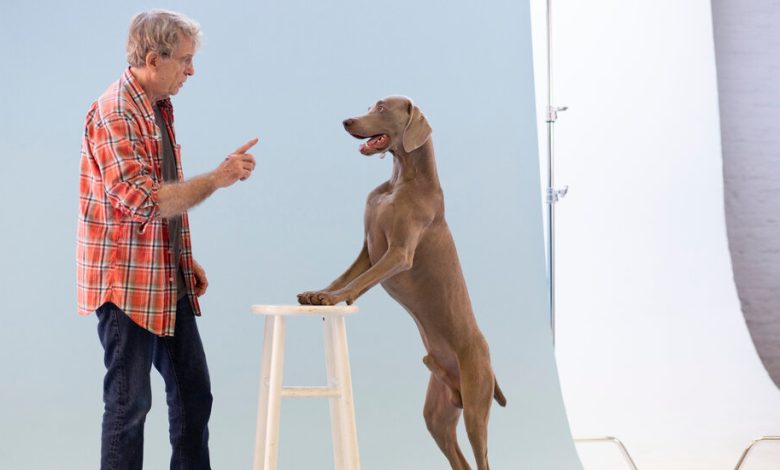Wegman Is Selling His Chelsea Home and Studio, Asking $16.5 Million

For the last three decades, the artist William Wegman has kept his main studio at 245 West 18th Street, a two-story, double-wide building in Chelsea. He painted on the top floor, and on the bottom, shot many of the well-known photographs and videos of his beloved Weimaraners in quirky costumes and poses.
Mr. Wegman and his wife, Christine Burgin, also had part of their family home on the upper level, which was connected to the second floor of a neighboring building they co-owned. When that building, No. 239-243, was sold in 2019, the empty-nester couple renovated the floor above the studio to use as their Manhattan residence.
But then Covid hit, and they left the city for their country home in Ghent, N.Y., where Mr. Wegman maintains another studio. (They also own a lakefront lodge in Rangeley, Maine.) “Everything changed with the pandemic,” said Ms. Burgin, 63, a book publisher and former art gallery owner, adding that Mr. Wegman’s main assistant also relocated upstate. “It was easier to run a studio there,” she said.
Now looking to make the transition permanent, they have decided to sell the 18th Street building. Their asking price is $16.5 million, according to the listing broker, Raphael De Niro of the De Niro Team at Douglas Elliman Real Estate; annual property taxes are $81,870. Mr. Wegman, 79, bought the building in 1994, paying “under $1 million,” he said, after outgrowing his East Village studio.
The brick, fortresslike structure, covered in ivy, sits between Seventh and Eighth Avenues. It measures 45.5 feet wide and encompasses 5,834 square feet inside, not counting the basement, with a spacious garage in the front that opens to the studio. There is also a 43-by-50-foot landscaped garden with irrigation on the second floor, and a rooftop, where Mr. Wegman, an avid hockey fan, would shoot pucks with his son, Atlas, under the watchful eyes of his dogs.
“One of us would shoot a different corner and the other tried to deflect it,” said Mr. Wegman, who often skated at nearby Chelsea Piers. He also belongs to a senior hockey league in Schenectady, N.Y.
The Chelsea building was erected in 1915 and used mainly for commercial purposes. Before Mr. Wegman and Ms. Burgin moved in, it had housed the Chelsea Day School, a preschool, and a wholesale plant business.
Mr. De Niro plans to market the property for both commercial and residential use. “It doesn’t fit neatly into any one specific box,” he said, “and that’s the beauty of it. It can be a development opportunity or a personal compound.”
It can also be a much taller building. “There are more than 18,000 square feet of unused air rights,” Mr. De Niro said. “It could be developed into something larger.” (Mr. Wegman said he had considered adding on two floors, “but we decided it was too expensive.”)
Right now, the building is configured as a live-work space. A small front lobby on the ground floor leads to the cavernous 42-by-65-foot studio, chock-full of camera and editing equipment, along with racks of costumes and props that Mr. Wegman has used in his photo shoots. His Weimaraners have been decked out in wigs, suits, dresses, as well portrayed as recognizable characters in classics like “Little Red Riding Hood” and “American Gothic.”
“The dogs had a full wardrobe of clothing,” Ms. Burgin said.
“And they look good in them, too,” Mr. Wegman added.
Over the years, Mr. Wegman has owned several Weimaraners, though he’s down to just one now: Flo. “Topper passed away this past summer,” he said.
His studio has a chic industrial aesthetic, with two skylights, heated concrete floors, tall beamed ceilings with hanging lights and exposed pipes. The space includes a storage area, a powder room, bathroom with a shower, and a pantry.
There’s a separate exterior entrance to the fully renovated apartment, as well as stairs off the pantry to that unit.
The heart of the apartment is a 32-by-21-foot great room, where there are areas for lounging and dining, and an open kitchen that leads out to the garden. The kitchen is equipped with dark soapstone countertops, painted birch cabinets and high-end stainless-steel appliances.
A library with a skylight and two walls of built-in bookshelves is flanked by two similarly sized bedrooms, each with a couple of closets. And near the entry hallway, lit up by another skylight, is a laundry area and a mosaic-tiled bathroom.
The apartment also has vintage pine flooring, beamed ceilings and oversize windows.
Throughout the building are many of Mr. Wegman’s works — some displayed, others in storage — including the dog photographs that made him famous, gracing books, magazines, product ads and museum walls. He has also received acclaim for his paintings incorporating found postcards and has written numerous art and photography books.
Mr. Wegman says he’ll miss his Chelsea home. “I became friendly with the doormen, barbers — people you’d see all the time,” he said. “And the dogs were used to it there.”




